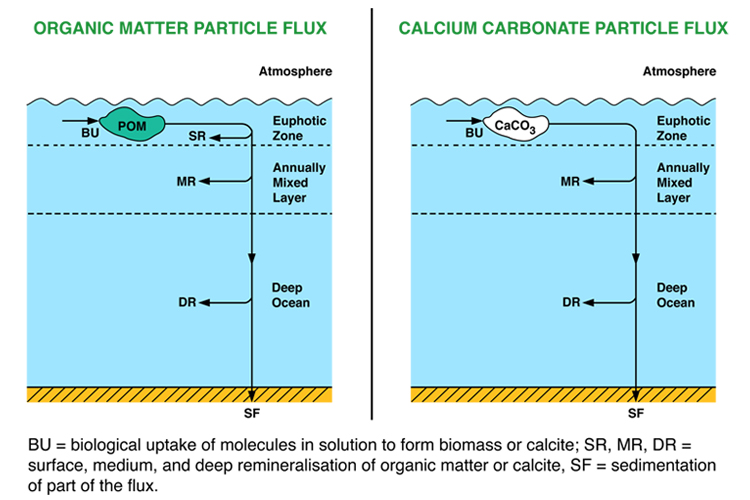
Overview
This model is very simple. It is stripped down to the simplest form that can still reproduce the carbon (C) and phosphorus (P) cycles. That is to say, the simplest form that is still able to capture the main aspects of how atoms of carbon and phosphorus enter the ocean, are transported about within it, and then finally leave the ocean. Since the ocean's carbon cycle interacts and exchanges carbon with the atmosphere this model includes an atmospheric reservoir for this element (unlike the other nutrient cycle models). The aim of this model is to understand how the ocean responds to changes in its carbon cycle driven by anthropogenic emissions of CO2 to the atmosphere, with a particular emphasis on ocean acidification and carbon isotope distribution.
The diagram to the right shows how the oceanic cycle of phosphorus is represented in the model. The modelled carbon cycle is tightly coupled to that of phosphorus, so is not shown separately here. The model represents how atoms of carbon and phosphorus enter and leave different substances (for instance, bodies of living organisms or molecules of CO2 and phosphate) during their time in the ocean and atmosphere.
Unlike the other nutrient models, where only the surface and deep ocean are resolved, here the model is a three-box model of the global ocean, where the uppermost box represents the euphotic surface layer, the middle box represents the seasonal limit of the deepest wind-induced mixing and the lowest box represents the deep ocean below the influence of wind and waves.
Other related pages
Carbon model overview
Carbon model pros
Carbon model cons
Carbon model more details
Carbon model worksheet
Refrences
Chuck, A. et al. (2005). The oceanic response to carbon emissions over the next century: investigation using three ocean carbon cycle models. Tellus B 57, 70-86.
Tyrrell, T. (1999). The relative influences of nitrogen and phosphorus on oceanic primary production. Nature 400, 525–531.
Tyrrell, T. et al. (2007). The long-term legacy of fossil fuels. Tellus B 59, 664-672.
External links
Description of the chemical element carbon, Wikipedia
Description of the chemical element phosphorus
Description of the phosphorus cycle